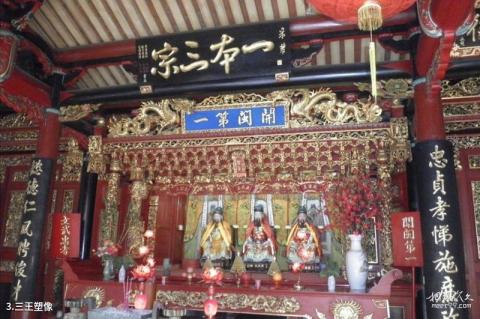
Introducción a las estatuas de los Reyes Magos: Los pilares de piedra a ambos lados del salón ancestral están tallados con tres pares de coplas que alaban los logros de los Reyes Magos al abrir Fujian y regular los manantiales. Se conservan los componentes originales del edificio, incluidos leones tallados en vigas de lámparas y de pino, patrones de madera tallada en vigas y columnas, y flores y árboles en soportes. En el centro de la sala hay un magnífico nicho tallado, en el que están consagradas las estatuas de Wang Chao, Wang Shengui y Wang Shenzhi. En 885 d.C., tres hermanos, Wang Chao, Wang Shengui y Wang Shenzhi, lideraron un ejército de levantamiento campesino en Fujian en el condado de Gushi, Guangzhou, Henan, unificaron Fujian y establecieron el país de Fujian. Son conocidos en la historia como los "Tres". Reyes que abrieron Fujian". De la viga frontal del salón ancestral cuelga una placa con la inscripción del ex primer ministro de Singapur, Wang Dingchang, con el título "El primero en abrir Fujian". De la viga trasera cuelga una de las escrituras de Song Mifu "Un libro y tres sectas" y una placa con la inscripción ". Wang Jinping, un conocido taiwanés, con el título "Guang Qian Yu Hou". El ambiente general es solemne y solemne. En la galería en el lado oeste del mojón de piedra fuera del templo principal, hay 12 esculturas de sombras de piedra azul de "Pinturas históricas de los Tres Reyes de Fujian en las Cinco Dinastías" incrustadas en ellas, que reproducen los logros históricos de los "Tres Reyes".
